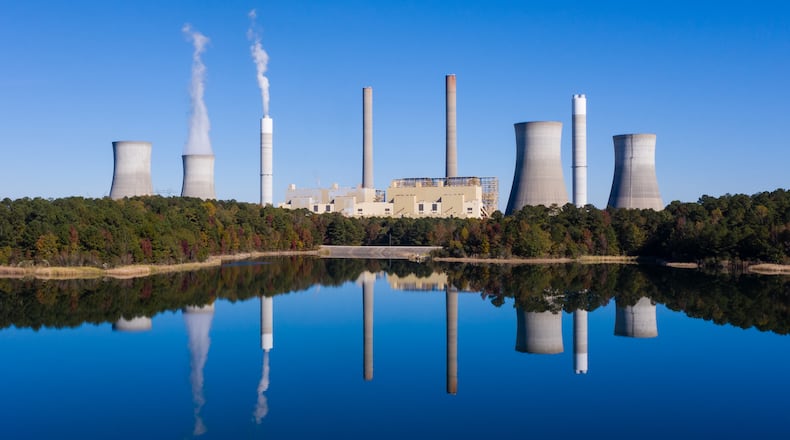Facing what the company says is an onslaught of electricity demand driven by energy-hungry data centers, Georgia Power proposed Friday to add more renewables, upgrade aging nuclear units and modernize its hydropower dams.
At the same time, the utility now wants to keep two of the country’s largest coal power stations online beyond their scheduled retirement dates — units company executives said only three years ago made little economic sense to keep running much longer.
Those are among the proposals Georgia Power has included in its new long-range energy road map, known as an Integrated Resource Plan, which was submitted Friday morning to the Public Service Commission.
The filing kicks off a monthslong process that will shape the utility’s energy mix and its emissions of planet-warming pollution for years to come, all set to be decided by the votes of the PSC’s five commissioners, all Republicans.
The price tag of Georgia Power’s proposal was not made available and the plan won’t immediately affect customers’ bills — that will be decided in a separate case starting later this year. But cost discussions are likely to figure prominently in the proceedings because the approved plan will ultimately dictate how much customers pay for their electricity.
Georgia Power earns profits on capital costs for building power plants, transmission lines and upgrading infrastructure — costs that are typically recovered from customers through rates. Since late 2022, the utility’s customers have faced a slew of PSC-approved rate hikes that have pushed the average customer’s bill up by about $43, according to company data.
Concern has also been growing about whether the rush to serve data centers, electric vehicle factories and other “large load” customers could saddle homeowners and businesses with even higher bills. An Atlanta Journal-Constitution analysis published Thursday found Georgia Power’s peak demand forecasts in recent years often overstated demand.
Aaron Mitchell, vice president of pricing and planning at Georgia Power, said more than 80% of the electricity demand growth the company is projecting comes from data centers, which require huge amounts of 24/7 power.
“The 2025 IRP provides a comprehensive plan to support Georgia’s continued economic growth and serve Georgians with clean, safe, reliable and affordable energy well into the future,” Georgia Power CEO Kim Greene said in a statement.
Coal isn’t dead yet
The company’s proposal includes plans to keep burning coal at Plant Scherer near Macon and Plant Bowen outside Cartersville well into the 2030s. The plan also calls for keeping units at Plant Gaston, a coal and gas-burning plant southeast of Birmingham, running beyond their scheduled 2028 closure date.
One of Scherer’s units had been set to retire by the end of 2028, while Bowen’s final closure date was still to be determined coming into this case. The company now says it wants to explore upgrades at both plants to allow them to “co-fire” coal and natural gas, potentially keeping them in service even longer.
Just three years ago, Georgia Power seemed eager to phase out coal, with executives calling its remaining plants “uneconomical.” But Mitchell, the utility’s VP, said the company’s new analyses now show otherwise.
“We’ve done an economic evaluation on those … and the result of that shows that they are cost effective and the right decision for us to continue operating to serve customers,” Mitchell said.
Credit: Elijah Nouvelage
Credit: Elijah Nouvelage
Environmental groups criticized the company’s plan to delay the coal closures.
Burning coal for power is a less efficient way to generate electricity than burning gas or oil, according to the federal Energy Information Administration. Coal fired power also contributes more greenhouse gas pollution than other fossil fuels and solar, which produces no emissions to generate electricity. Costs for both coal and gas are also notoriously volatile, and critics of the company said its plan to continue to lean on fossil fuels would expose customers to price spikes.
“We’re the No. 1 state to do business and one of the U.S.’s fastest growing tech hubs. Are we really going to power progress with gas and coal?” asked Jennifer Whitfield, a senior attorney at the Southern Environmental Law Center. “Coal hasn’t been economic for years, and paying for even more methane gas is incompatible with the future Georgians want and businesses are demanding.”
The company also wants to:
- Solicit bids to add another 1,100 megawatts of renewable energy from solar and hulking batteries known as battery energy storage systems. Georgia Power says it now aims to have 11,000 megawatts of renewables online by 2035.
- Execute upgrades to boost the output of oil and gas-fired units at Plant McIntosh near Savannah by 268 megawatts.
- Upgrade nuclear units at Plant Hatch west of Savannah and Plant Vogtle near Augusta to unlock 112 megawatts of extra power. Plant Hatch’s reactors have been in operation since the 1970s. The units at Plant Vogtle that would be updated are the decades-old Units 1 and 2 — not the two new reactors that were completed in 2023 and 2024.
- Modernize nine existing hydroelectric dams across the state, which Georgia Power says will allow them to operate for at least 40 more years.
- Build new transmission infrastructure along more than 1,000 miles of power lines.
Georgia Power also proposed a new pilot program for residential and small commercial customers to install solar and battery systems at their homes and businesses, creating what some dub a “virtual power plant.”
Under the proposal, customers would own the solar and battery hardware, but Georgia Power could call on their electricity to use when demand spikes. In return, customers would earn bill credits.
Forecasts under scrutiny
Georgia Power’s road map — and the forecasts that underpin it — will be dissected in the coming months by a range of environmental groups, cities, consumer advocates and the PSC’s own public interest staff.
The company has recently forecast skyrocketing demand for its power into the 2030s. Based on those projections, in 2023 Georgia Power made a surprising request to add thousands of megawatts of new capacity, which its executives testified was overwhelmingly needed to serve data centers.
Georgia Power’s new forecast released Friday lowered its projected needs slightly over the next three years compared to estimates released in 2023, but still show demand rising into the next decade and beyond. The utility says it expects its electricity needs will grow by roughly 8,200 megawatts over the next six years.
But analysis by the AJC shows Georgia Power has often overestimated actual peak demand for its electricity.
In response to the findings, Georgia Power spokesperson Jacob Hawkins said earlier this week that the company uses “the best information and forecasts we have available.”
Data center protections
While the PSC begins to weigh Georgia Power’s proposal, efforts are underway to protect residential customers and other businesses from the main driver of the company’s request: the state’s data center influx.
Last week, the PSC approved changes to Georgia Power’s rules and contract provisions commissioners say will allow the company to charge data centers more.
Asked whether the company feels more steps are needed to ensure data centers pay their fair share and protect other customers, Mitchell said he thinks Georgia Power now has “all the tools necessary.”
Credit: arvin.temkar@ajc.com
Credit: arvin.temkar@ajc.com
But state legislators are still exploring other options.
Earlier this week, Sen. Chuck Hufstetler, R-Rome, introduced a bill that would require utilities to charge data centers for costs “substantially related to” providing their electric service, potentially adding another layer of protection for other customers.
A House Special Committee on Resource Management led by Rep. Brad Thomas, R-Holly Springs, began meeting this week and is likely to investigate energy and water consumption by data centers.
A note of disclosure
This coverage is supported by a partnership with Green South Foundation and Journalism Funding Partners. You can learn more and support our climate reporting by donating at ajc.com/donate/climate.
About the Author
Keep Reading
The Latest
Featured




